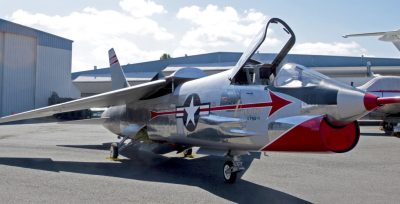Everett, WA — March 25 marks the 60th anniversary of the first flight of one of the Museum’s most historic military jets–the Chance Vought XF8U-1 Crusader. Seattle’s Museum of Flight will celebrate the date during an 11 a.m. ceremony with the aircraft at the Museum’s Restoration Center and Reserve Collection on Paine Field, Everett, Wash. The event is also the first presentation of the plane after its decades-long restoration.
The occasion will bring together many Navy and Marine Corps veterans from around the country who flew Crusaders during their military service. Other speakers include the Museum’s Curator, Dan Hagedorn, and Tom Cathcart, Director of Aircraft Collections & Restoration. Members of the plane’s restoration team will also be in attendance. The event is free. Admission to the Restoration Center is also free on that day.
The Museum‘s Crusader
The Museum’s Crusader is the first prototype of this family of military jets that soon set astonishing flight records in the 1950s, and during the Vietnam War became a weapon known as “The last of the gunfighters.”
The Crusader was designed and built by Chance Vought to fulfill the Navy’s wish in the early 1950s for a supersonic fighter. The long, low jet not only fulfilled the requirement, but also proved to be an enduring design that served for decades. The Museum’s plane is the first prototype, the XF8U-1, and is the first fighter ever to be flown past Mach 1 on its maiden flight. The plane was used as a test aircraft until its retirement about five years later.

The Smithsonian National Air and Space Museum loaned the aircraft to The Museum of Flight in 1987 (later donating it in 2004). Restoration of the plane began in earnest at the Museum’s Restoration Center in 1996. “Dash One,” as it was sometimes known, now reflects the plane’s configuration and livery seen during its March 25, 1955 first flight. The aircraft will be installed in the Museum’s Great Gallery.
Crusader History
Aviation’s prestigious Collier Trophy was awarded to the Navy and Chance Vought for the Crusader, “for concept, design and development of the first carrier-based fighter capable of speeds exceeding 1,000 mph.” It won the Thompson Trophy in 1956 for setting a national and world speed record of 1,015.428 miles an hour. It was the first aircraft to span the nation faster than the speed of sound (flown on that flight by John Glenn), and it won the first Certificate of Merit ever awarded by the Navy’s Bureau of Aeronautics.
The Crusaders served for 45 years. They were flown by the U.S. Navy and Marine Corps during the Vietnam War, served Philippine Air Force into the 1990s, and was finally retired by the French Navy in 2000. NASA used two highly modified Crusaders in the 1970s as research aircraft that pioneered digital fly-by-wire systems, the “supercritical wing,” and in support of the space shuttle flight controls.
